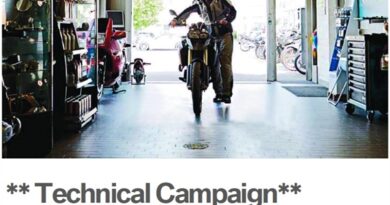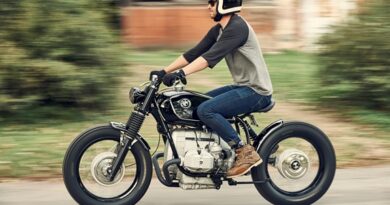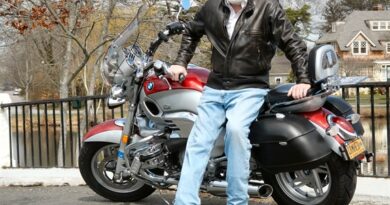Tech Q&A: More brake problems
Q:
Dear Nicht Uber Max: My father and I have been working on a problem with the front brake system on his 1996 R 1100 RT. The system will pressurize with no input of the brake lever to the point that the bike is immobilized and brake fluid seeps from the master cylinder. I’m sure if you would let the bike run after it clamps the front wheel it would blow the cover off the master cylinder. We have at this point replaced all lines with braided stainless, rebuilt the master cylinder, blown out ABS module, and fully rebuilt the Brembo calipers, but it’s still not working properly and the bike is indefinitely sidelined. –Doug W. via Facebook
A:
Let’s begin with the assumption that you are not over the maximum mark for filling the brake fluid reservoir on the handlebar. It’s important to stay at or below the max mark (remember – NICHT UBER MAX!) because that allows expansion room for the fluid as it heats up under normal use.
On some older Ducatis, the rear brake line was routed so close to the exhaust pipe that it would heat up the fluid, causing it to expand enough to clamp the rear brake tight. This was made worse if the pedal wasn’t properly adjusted, but it was a problem either way. Since you don’t have a Ducati, though, this probably isn’t what’s going on. Thinking about those Ducatis, though, you said “run the bike.” With the Ducatis, this was an issue at idle after the bike was warmed up. Do you really mean “ride the bike,” as in this happens while you’re riding or is it happening at idle?
Since fluid is coming out the master cylinder, this gives me three ideas: the master cylinder itself, the piston that connects the brake lever to the master cylinder and your hard brake lines.
The first thing to do is check what you’ve already done, and in this instance my initial suspicion is the master cylinder rebuild, especially given that it’s an 1100. In early 1100s such as yours, the master cylinder bore was not anodized, which can promote corrosion and scoring and lead to blockages. It’s possible when the master cylinder was rebuilt that the bore wasn’t checked or properly cleaned. If there’s debris in there blocking the bore, it would prevent fluid from returning to the master cylinder, thus keeping the calipers clamped down.

The second thing it could be is the brake lever piston adjustment. If the brake lever was replaced or damaged and subsequently not adjusted to spec, then this could be keeping the system pressurized, much as if you were constantly riding the brake. When you rebuilt the master cylinder, the piston could have been slightly misadjusted or misaligned. This could partially block the return port for the brake fluid. Effectively this would keep the brake pressurized and the caliper clamped tight to the disc. This would result in the brake fluid heating up and you might see fluid seeping from the master cylinder cover as the pressure and heat cause the fluid to expand and move forcibly.
Third (but least likely) is that you have a problem with your hard steel brake lines. If they are filling up with plaque—not unlike an old man’s arteries do-then this would create the kind of pressure you’re seeing (as well as excess heat while riding) and cause the brakes to always drag and refuse to release. Upgrading your rubber brake lines to the stainless steel braided ones, while a good upgrade, would not solve this problem. The pressure generated by applying the brakes is subject to the principles of hydraulics in that if you squeeze fluid from a large hose into a smaller hose and that smaller hose is partially blocked with goo, the fluid will move one direction more easily than the other. So what you could be seeing here is fluid that flows to the calipers goes through the hard lines just fine, but because of possible blockages, that fluid cannot flow back through the hard lines because there is very little pressure moving the fluid in that direction. If you want to look up the principles of hydraulic multiplication of force, that may explain this concept in more depth.
Q:
Dear Nicht Uber Max: George, I’m surprised at your response to Doug’s question. Doug mentioned that the bike had ABS and that they had “blown out the ABS module,” but you made no mention of the ABS module in your response. I know nothing of motorcycle ABS; however, ABS modules in automobiles include a pump that returns brake fluid released to control braking pressure into the pressurized system. That keeps the brake pedal from dropping out from under the driver’s foot as a result of ABS activation.
Could it not be that something in the ABS module has gone awry and that fluid is being pumped back to the master cylinder, creating the leakage that Doug comments upon? If that is not possible, would it not then be appropriate for your response to rule it out?? –Brant M.
A:
Brant, The R 1100 RT used an ABS pump that, when in ABS mode, shunts the flow from the master cylinder. This prevents the lever from “going to the floor.” If you stay in ABS mode long enough, eventually you will “go to the floor.” Every time the pump cycles you lose a tiny bit of pressure until it reads wheel slip and reactivates. It has no way of pushing fluid back to the master.
Doug’s complaint was during normal operation, not in ABS mode. During normal operation, his ABS pump is passive. If the pump were running when not needed, he would have heard it and lost pressure. I had an R 1100 RS that would go into ABS mode when not needed. The only way to stop the bike was to release the brakes, turn off the key and reapply the brakes.
If Doug had a modern, linked system (post IABSI), what you are describing is possible. In those models, a stepper motor is used to activate the caliper of the non-applied circuit. This causes a slight push back at the non-applied lever. If the lever was not adjusted correctly and the reservoir was over-filled, it would be possible to build pressure in the reservoir. Hope that answers your question.
If you’re having a problem with your motorcycle that you’d like to see addressed, send your questions or issues to [email protected], and we’ll address your problem in a future installment.
George Mangicaro is an independent BMW motorcycle mechanic, formerly a trained, certified, dealer-employed BMW expert technician. He now runs Gridlock Motors in Warrenton, Virginia, and works on all generations of BMW motorcycles, plus some Urals (if you’re nice) and minicars.



